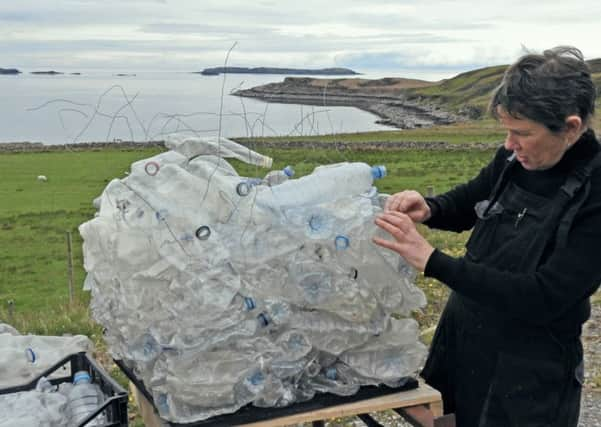Plastic sculptor sends urgent message in bottles


Award-winning environmental artist Julia Barton has created giant cubes made out of rubbish found on Scottish beaches to demonstrate the scale and nature of the waste being washed up.
The exhibition has opened on Ullapool beach, where around 80 people braved dreich weather to take part.
Advertisement
Hide AdAdvertisement
Hide AdThey helped to collect seven common types of plastic waste and build further LitterCUBES to add to the installation.
Each cube has a story to tell, Barton says. By weighing the constructions, she helps participants calculate the energy value of the plastic contained within each as an equivalent quantity of oil.
The exhibition will go on tour to seven locations across Scotland over the next few months.
Barton says her work is driven by her concern for Scotland’s seas and nature and her determination to draw attention to society’s wasteful ways.
“I’m passionate about protecting our amazing marine and coastal environment,” she said. “I want the LitterCUBES to be a trigger for discussion: how to stop plastic waste bleeding into our seas, and what we can do to change plastic use and save valuable petrochemical resources.”
One of the first LitterCUBES to go on the scales in Ullapool was made out of polyethylene terephthalate (PET) drinks bottles.
Measuring 60 centimetres cubed, it weighed in at 8.2kg and contained the energy value of 9.84 litres of oil.
After Ullapool, events will be staged on beaches at Dunbar, Lerwick, Scalloway, Arbroath, Edinburgh and Eyemouth. Barton will also be hosting a talk at the Dunbar event, offering participants a chance to discuss the project.
Advertisement
Hide AdAdvertisement
Hide Ad“The cubes will be exhibited, then they will go to be recycled,” said Barton.
She has worked with Scotland’s coastal communities for more than six years, investigating beach litter in creative ways.
“My work is rooted in sculpture, but crosses many disciplines,” she said. “I now primarily make temporary installations, often with interactive elements. I respond to my experience of place and am increasingly inspired to make work that draws attention to our wasteful society and the sustainability of our environment.”
Barton received a Shetland Environmental Award from the Shetland Amenity Trust for her Littoral Art project’s educational work in 2017 and presented her findings to MSPs at the Scottish Parliament last year.
Sita Goudie, environmental improvement officer for Shetland Amenity Trust, said: “Julia’s creative approach really makes you think about this serious environmental issue and how we can all influence the amount of litter entering the marine environment.”
Estimates suggest up to 12 million tonnes of plastic waste ends up in oceans around the world each year. About a million seabirds and 100,000 marine animals such as whales, dolphins and turtles are killed by plastic pollution every year.
For further details visit www.littoralartproject.com.